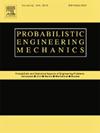利用统计复杂度度量检测和量化由lsamvy噪声驱动的分数阶双稳耦合系统的随机共振
IF 3
3区 工程技术
Q2 ENGINEERING, MECHANICAL
引用次数: 0
摘要
本文分析了两个分数阶双稳系统在相互耦合和独立lsamvy噪声刺激下的随机共振现象。利用统计复杂度和归一化香农熵通过调制lsamvy噪声和给定系统的参数来表征随机共振。在最佳噪声强度水平下,统计复杂度的最大值和归一化香农熵的最小值作为动态复杂性和随机共振发生的严重程度的指标。然后,通过统计复杂度度量揭示了各种参数对随机共振的影响。数值结果表明,可以找到适当的耦合强度来增强随机共振效应。两个子系统的复杂度一致性与它们之间的耦合程度呈正相关。在较低噪声水平下,存在最优分数阶导数,这增加了系统的复杂性,使随机共振现象更加明显。在较高的噪声水平下,分数阶导数通过使系统的演化完全随机来抑制随机共振的出现。此外,增加外部周期信号的幅值和稳定性指数可以增强随机共振,而较大的偏度参数则会减弱随机共振。本文章由计算机程序翻译,如有差异,请以英文原文为准。
Detecting and quantifying stochastic resonance in a coupled fractional-order bistable system driven by Lévy noises via statistical complexity measure
In this work, we analyze stochastic resonance phenomenon in two fractional-order bistable systems that are mutually coupled and stimulated by independent Lévy noises. Statistical complexity and normalized Shannon entropy are utilized to characterize stochastic resonance by modulating the parameters of Lévy noise and the given system. It has been determined that the maximum of statistical complexity and minimum of normalized Shannon entropy are regarded as indicators of the severity of dynamical complexity and the occurrence of stochastic resonance, at an optimal level of noise intensity. Then, the influences of various parameters on stochastic resonance are also revealed by the statistical complexity measures. The numerical results demonstrate that the appropriate coupling strength can be found to enhance stochastic resonance effect. The consistency of the complexity of two subsystems is positively correlated to the degree of coupling between them. At lower noise levels, there exists an optimal fractional-order derivative that increases complexity of the system and makes stochastic resonance phenomenon more pronounced. At higher noise levels, the fractional-order derivative suppresses the appearance of stochastic resonance by rendering the evolution of system completely random. Furthermore, stochastic resonance is bolstered by increasing the amplitude of the external periodic signal and stability index, while it is weakened by a larger skewness parameter.
求助全文
通过发布文献求助,成功后即可免费获取论文全文。
去求助
来源期刊

Probabilistic Engineering Mechanics
工程技术-工程:机械
CiteScore
3.80
自引率
15.40%
发文量
98
审稿时长
13.5 months
期刊介绍:
This journal provides a forum for scholarly work dealing primarily with probabilistic and statistical approaches to contemporary solid/structural and fluid mechanics problems encountered in diverse technical disciplines such as aerospace, civil, marine, mechanical, and nuclear engineering. The journal aims to maintain a healthy balance between general solution techniques and problem-specific results, encouraging a fruitful exchange of ideas among disparate engineering specialities.
 求助内容:
求助内容: 应助结果提醒方式:
应助结果提醒方式:


